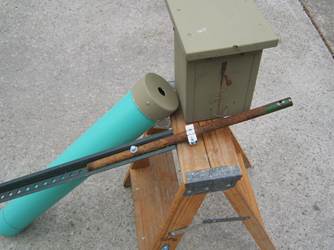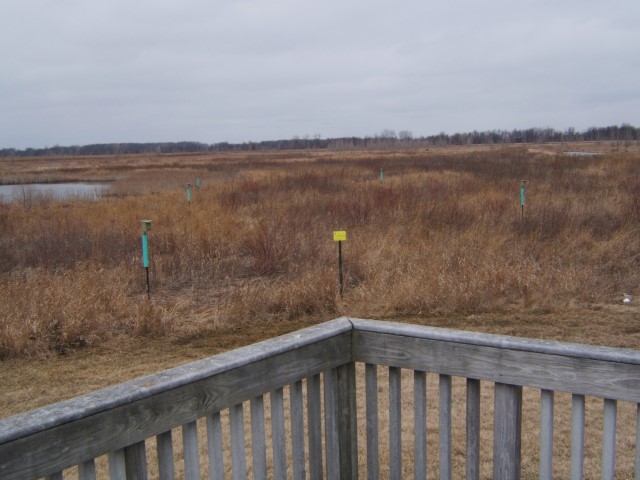
Nestboxes in storage do not produce birds. After I had dismantled 26 nestboxes from a bluebird trail with a 38-year history, I looked at them sitting on four shelves in my garage and I wondered where could I transplant them so they could continue to raise birds? Soon, I had two locations in mind. One was a roadway ditch in front of a park that could sprout nestboxes out of the way of mowers while providing excellent habitats for aerial-feeding Tree Swallows and ground-feeding Eastern Bluebirds.
A second candidate was an elementary school where a wide drainage ditch saturated with cattails led to a large pond surrounded by lots of open space. Presently, both locations could use mosquito control for the safety of our species.
I was close to making a choice as to whom to approach with my idea of transplanting nestboxes from my garage in order to apply conservation techniques that promised good insect control with many educational opportunities when I received an email from Donna Daniel of the Ohio Division of Wildlife. For decades, volunteer Michael Bailey had maintained and monitored nearly fifty nestboxes at the Big Island Wildlife Area in Marion County and he was moving from the area following retirement. The division was searching for a successor to an exceptional bluebirder.
Harry Condry stepped up to take on the rewarding task. Since the early 1980’s, Harry has been the effective bluebirder at the Army Corps of Engineers’ Alum Creek Dam where he presently maintains 23 nestboxes and a gourd rack of eight gourds that have raised Purple Martins since 2001. For the last three years, Harry has managed 13 boxes throughout the prairie at the OSU campus in Marion. I have known Harry for years as we are both charter members of the WRRC, founded by Don Burton, that later changed its name to the Ohio Wildlife Center.
On March 20, I joined Harry for a tour of the 3,800 acre area as a guest of Manager Tim Davis. The main objective was to locate 46 nestboxes, but seeing several of the area’s five eagle nests was an extra bonus. The wildlife observation deck caught my attention as I saw a future home for my 25 nestboxes. The deck is elevated so bird watchers can see extra acres of prairie and wetlands. Ducks, eagles, and swans were common sights as I became obsessed with hope for a new nestbox grid for Tree Swallows.
Once home, I began preparing to transplant my boxes from garage to wetland. I purchased five 15-foot lengths of four-inch green drainpipes. I used my table saw to cut each pipe into five 33-inch-long baffles. For each baffle, I drilled a 7/8-inch hole in the center of a plastic cap. I used three small screws to hold each cap to its baffle. After I assembled the baffles, I painted their white caps with Pratt and Lambert’s “Yucca Green” to match the nestboxes. The baffles hang from 20-inch lengths of one-half-inch gas pipe that I have salvaged from former bluebird trails. After I used a pipe cutter to cut 25 lengths of suitable pipe, I drilled two 9/32-inch holes in each; one hole one inch from one end for the nestbox, and the other hole was drilled five inches from the opposite end for it to be bolted to a steel post. An electric conduit clamp, size #0, is bolted to the pipe nine inches from the end drilled for the nestbox’s bolt. The conduit clamp supports the baffle below the nestbox.

Big Island supplied the seven-foot-long poles for the grid. The grid poles are smaller and lighter than U-posts typically used to hold stop signs and Wood Duck boxes, but they are similar by having bolt holes in their spines spaced every inch. I learned that the use of the grid poles helps the local economy since they are manufactured in Marion, Ohio.
Harry and I agreed to meet at 9:00 on Friday, March 27 to pick up poles and install the grid. We were joined by wildlife technician Andy Landon who saved us hours of intense labor. Andy brought along the unit’s four-wheeled Gator that hauled the poles, nestboxes, baffles, and pipe lengths. Nonetheless, we worked without breaks for the next four hours in below freezing temperatures.
First, we used two 100-foot measuring tapes and two rolls of chalk line to put into practice the Pythagorean Theorem in order to lay out the grid with nestboxes 25 yards apart at right angles. We measured 45 feet out from the deck’s two corners on its west side. We pounded two tall stakes into the ground and stretched a chalk line north to south that barely touched the stakes as a third point was agreed upon for the first nestbox location. We pounded in the first post which became the first box location for the southern-most row of boxes. From this first stake, we pulled the tape to measure 80 feet to the north with the tape barely touching the first two wooden stakes. At 80-feet, we drove a third wooden stake into the ground.
Back at the original steel post, the second tape was used to measure 60 feet to the west, then from the north stake at 80 feet, the tape was pulled 100 feet to cross the second tape at 60 feet to complete a 3-4-5 right triangle with sides measuring 60, 80, and 100 feet, respectively. Once a right angle is established, a combination of chalk lines and measuring tapes were used to lay out a grid of nestboxes spaced at 25 yards, or 75 feet, apart. When we finished, we had a grid made up of three rows of seven boxes each, one row of three boxes, and a lone box on the deck’s east side that stands very near a wetland. The rows line up beautifully, and since they are corners of squares, boxes also line up diagonally. The grid’s boxes surround the deck on three sides and the grid measures 75 x 150 yards.
Of course, birds don’t care about right angles and symmetry, but such exactness catches the eye of many people. As for birds and people, nestboxes should point in an arc from east to south so entrances can catch the morning sun while avoiding overheating due to afternoon sunlight. Keeping this and the viewing public in mind, we aimed the boxes from east to south while making sure that all entrances can be seen by bird watchers on the deck.

We installed a yellow sign titled “Wildlife Management for Tree Swallows” a short distance from the deck. This sign explains the spacing of the boxes and the fact that the avian inhabitants will consume more than 300,000 small insects during the 45-day period when each box is used to raise a family. Why didn’t we tack the sign to the deck itself? I have had three different photographers show and tell me that they were extremely happy to photograph swallows perched on grid signs at the Delaware Wildlife Area. Swallows perched on the signs produce good composition for photographs.
Hopefully, the Big Island grid will inspire many of its visitors to establish their own grids. I have recently counted four grids in Delaware County on private lands and I hope the idea continues to grow. Beavers were the original grid makers before the European Fur Market arrived in the 1600’s. As far as formal education goes, Elgin High School is two miles away if you are a crow, and three road miles away for our species. Yes, the high school and the wildlife area do interact and the grid is an added educational resource. This all makes me feel good since I am a member of the 1962 class from Prospect High School, the last class before consolidation to form Elgin. In addition, during my genealogical quest to find ancestors in the late 1970’s, I located farms close to the northwest corner of the wildlife area where five of my ancestral families settled in the early 1800’s. They came from Massachusetts, Connecticut, and one family migrated directly from England, so in more ways than one, the grid at Big Island is a full circle accomplishment for me.
And, so far, individual visits to see how things are going, tell us that every nestbox in the new grid has been claimed by Tree Swallows, thanks to the previous dedication of Michael Bailey.
